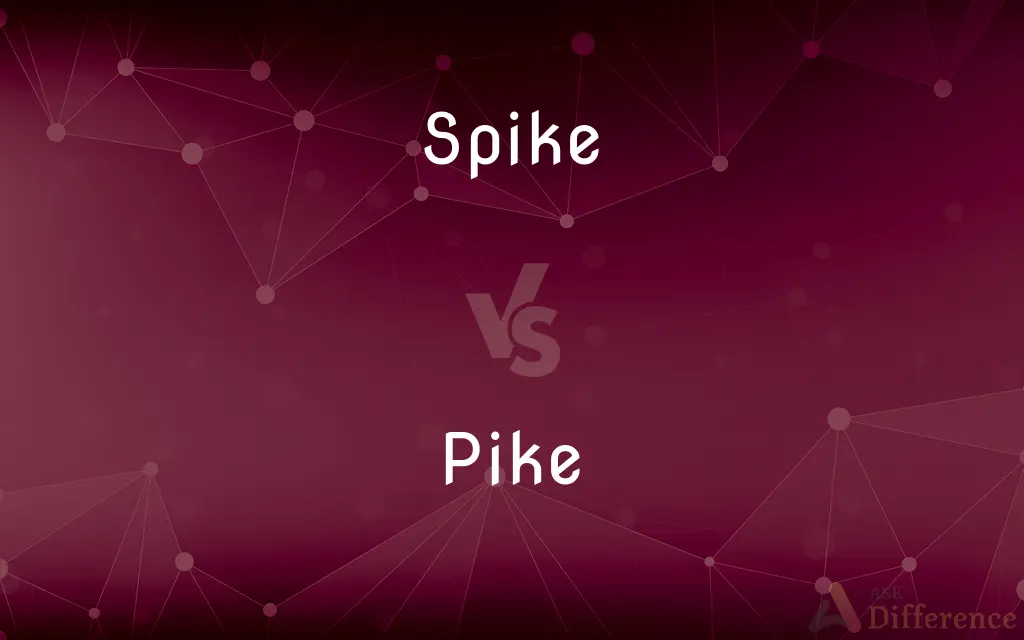Spike vs. Pike — What's the Difference?
By Fiza Rafique & Urooj Arif — Updated on March 10, 2024
A spike is a sharp, pointed object or projection, often used as a tool or weapon, while a pike is a type of long, thrusting spear or pole weapon, historically used in infantry.

Difference Between Spike and Pike
Table of Contents
ADVERTISEMENT
Key Differences
Spike and pike, while both referring to objects with pointed ends, serve different purposes and come from different historical and functional contexts. A spike can be any sharp, pointed piece of metal, wood, or other material, used for various purposes like fastening objects together, as in nails or railroad spikes, or as a feature of tools or weapons. Spikes can be found in everyday items, sporting equipment, and even in nature, as in the spikes on certain plants or animals.
A pike is specifically a long weapon used primarily in the medieval and Renaissance periods by infantry soldiers. Pikes were designed for thrusting and were particularly effective in formations like the phalanx, where soldiers would present a forest of spearheads to the enemy. The length of a pike could vary but was typically between 10 to 25 feet, allowing soldiers to engage enemies from a distance.
While spikes can be part of various objects and serve multiple functions, including decoration, pikes are exclusively weapons with a historical context rooted in warfare. The design and use of a spike depend on its specific application, which can range widely, whereas pikes have a more uniform design focused on reach and piercing ability in combat.
The use of spikes in modern times is diverse, seen in construction, fashion, sports, and security (e.g., anti-climbing spikes), demonstrating their utility in various fields. Pikes, however, are now mostly obsolete as weapons and are primarily encountered as historical artifacts, in ceremonial roles, or in reenactments.
Despite their differences, both spikes and pikes share the common characteristic of having pointed ends designed to pierce or penetrate. However, their significance, use, and cultural connotations diverge significantly, reflecting their respective roles in human activity and history.
ADVERTISEMENT
Comparison Chart
Definition
A sharp, pointed object or projection
A long, thrusting spear used by infantry
Primary Use
Varied, including fastening, tools, and weapons
Warfare, specifically in medieval and Renaissance periods
Design
Depends on specific application
Long shaft with a pointed end for thrusting
Context
Construction, fashion, sports, security
Historical warfare, ceremonial roles
Functionality
Diverse, depending on the type of spike
Uniform, focused on reach and piercing ability
Compare with Definitions
Spike
Used in various applications, from construction to fashion.
Spikes on shoes for athletics improve traction.
Pike
Historically used in warfare by infantry.
Medieval armies used pike formations for defense and offense.
Spike
Often serves a functional purpose, like fastening.
Railroad spikes secure rails to ties.
Pike
Now mostly obsolete as a weapon.
Pikes are seen in historical reenactments rather than in modern combat.
Spike
Appears in everyday items and equipment.
Ice spikes are used for traction in mountaineering.
Pike
Characterized by its length, enabling reach in combat.
Renaissance pikes could be up to 25 feet long.
Spike
Can be a feature of natural organisms.
The spikes on a porcupine deter predators.
Pike
Part of phalanx and other military formations.
Soldiers in a phalanx would present a wall of pike heads to the enemy.
Spike
Can be used as a weapon or defensive tool.
Spiked clubs were used in medieval combat.
Pike
Can have ceremonial or symbolic roles today.
Ceremonial units may carry pikes in parades.
Spike
A long, thick, sharp-pointed piece of wood or metal.
Pike
A long spear formerly used by infantry.
Spike
A heavy nail.
Pike
A freshwater game and food fish (Esox lucius) of the Northern Hemisphere that has a long snout and attains a length of over 1.2 meters (4 feet). Also called northern pike.
Spike
A sharp-pointed projection along the top of a fence or wall.
Pike
Any of various fishes closely related to this fish, such as the muskellunge or the pickerels.
Spike
A thin, sharp-pointed vertical rod for impaling papers; a spindle.
Pike
Any of various fishes that resemble this fish.
Spike
An elongate unbranched inflorescence with sessile flowers.
Pike
A turnpike.
Spike
A thorn or spine.
Pike
A tollgate on a turnpike.
Spike
A tuft of hair that is stiffened, as with hair spray or soap, into a point.
Pike
A toll paid.
Spike
(Slang) A hypodermic needle.
Pike
A hill with a pointed summit.
Spike
One of several sharp metal projections set in the sole or in the sole and heel of an athletic shoe for grip.
Pike
A spike or sharp point, as on the tip of a spear.
Spike
Spikes A pair of athletic shoes having such projections.
Pike
A mid-air position in sports such as diving and gymnastics in which the athlete bends to touch the feet or grab the calves or back of the thighs while keeping the legs together and straight.
Spike
Spikes A pair of spike heels.
Pike
To attack or pierce with a pike.
Spike
An unbranched antler of a young deer.
Pike
To move quickly.
Spike
A young mackerel of small size, usually 15 centimeters (6 inches) or less in length.
Pike
A very long spear used two-handed by infantry soldiers for thrusting (not throwing), both for attacks on enemy foot soldiers and as a countermeasure against cavalry assaults.
Spike
A sharp rise followed by a sharp decline in a graph or in the tracing of a scientific instrument.
Pike
A sharp, pointed staff or implement.
Spike
A sharp momentary increase in voltage or electric current.
Pike
A large dry]] before adding to a haystack.
Spike
A sudden steep increase in prices.
Pike
Any carnivorous freshwater fish of the genus Esox, especially the northern pike, Esox lucius.
Spike
(Sports) The act of driving a volleyball at a sharp angle into the opponent's court by jumping near the net and hitting the ball down hard from above.
Pike
A position with the knees straight and a tight bend at the hips with the torso folded over the legs, usually part of a jack-knife.
Spike
(Football) The act of slamming the ball to the ground after succeeding in an important play, as after scoring a touchdown.
Pike
A pointy extrusion at the toe of a shoe.
Spike
(Football) The act of deliberately throwing the ball to the ground as an incomplete pass in order to stop the game clock.
Pike
Especially in place names: a hill or mountain, particularly one with a sharp peak or summit.
Scafell Pike is the highest mountain in England.
Spike
An ear of grain, as of wheat.
Pike
(obsolete) A pick, a pickaxe.
Spike
(Botany) A usually elongated, unbranched inflorescence with stalkless flowers arranged along an axis.
Pike
A hayfork.
Spike
To secure or provide with a spike.
Pike
A penis.
Spike
To shape into spikes.
Pike
(historical) A style of shoes with long toes, very popular in Europe in the 14th and 15th centuries.
Spike
To impale, pierce, or injure with a spike.
Pike
A gypsy, itinerant tramp, or traveller from any ethnic background; a pikey.
Spike
To injure with spiked shoes, especially when sliding in baseball.
Pike
(transitive) To prod, attack, or injure someone with a pike.
Spike
To put an end to; terminate
Spike a rumor.
Pike
To assume a pike position.
Spike
To add alcoholic liquor to
Spiked the punch with rum.
Pike
To bet or gamble with only small amounts of money.
Spike
To add a poison or other chemical to
A drink spiked with barbiturates.
Pike
Often followed by on or out: to quit or back out of a promise.
Don’t pike on me like you did last time!
Spike
To add flavor or spice to
"Miss Jane brought him ... cold spring water spiked with a dash of vinegar and a touch of molasses" (Howard Frank Mosher).
Pike
(intransitive) To equip with a turnpike.
Spike
To add excitement or vitality to
Spiked the speech with many jokes.
Pike
To depart or travel (as if by a turnpike), especially to flee, to run away.
Spike
(Sports) To hit (a volleyball) in a spike.
Pike
A foot soldier's weapon, consisting of a long wooden shaft or staff, with a pointed steel head. It is now superseded by the bayonet.
Spike
(Football) To throw (the ball) to the ground in a spike.
Pike
A pointed head or spike; esp., one in the center of a shield or target.
Spike
To render (a muzzleloading gun) useless by driving a spike into the vent.
Pike
A hayfork.
Spike
To manifest or undergo a sudden increase in (something) followed by a sharp decrease
Spike a high fever.
Pike
A pick.
Spike
To manifest or undergo a sudden increase followed by a sharp decrease
Traffic to the website spiked after the scandal broke.
Pike
A pointed or peaked hill.
Spike
A sort of very large nail.
Pike
A large haycock.
Spike
A piece of pointed metal etc. set with points upward or outward.
The trap was lined with spikes.
Pike
A turnpike; a toll bar.
Spike
(by extension) Anything resembling such a nail in shape.
Pike
A large fresh-water fish (Esox lucius), found in Europe and America, highly valued as a food fish; - called also pickerel, gedd, luce, and jack.
Spike
An ear of corn or grain.
Pike
A broad highway designed for high-speed traffic
Spike
(botany) A kind of inflorescence in which sessile flowers are arranged on an unbranched elongated axis.
Pike
Highly valued northern freshwater fish with lean flesh
Spike
A running shoe with spikes in the sole to provide grip.
Pike
A sharp point (as on the end of a spear)
Spike
A sharp peak in a graph.
Pike
Medieval weapon consisting of a spearhead attached to a long pole or pikestaff; superseded by the bayonet
Spike
A surge in power or in the price of a commodity, etc.; any sudden and brief change that would be represented by a sharp peak on a graph.
Pike
Any of several elongate long-snouted freshwater game and food fishes widely distributed in cooler parts of the northern hemisphere
Spike
The rod-like protrusion from a woman's high-heeled shoe that elevates the heel.
Spike
A long nail for storing papers by skewering them; (by extension) the metaphorical place where rejected newspaper articles are sent.
Spike
(volleyball) An attack from, usually, above the height of the net performed with the intent to send the ball straight to the floor of the opponent or off the hands of the opposing block.
Spike
(zoology) An adolescent male deer.
Spike
The casual ward of a workhouse.
Spike
Spike lavender.
Oil of spike
Spike
Synonym of endpin.
Spike
(theater) A mark indicating where a prop or other item should be placed on stage.
Spike
A small project that uses the simplest possible program to explore potential solutions.
Spike
To fasten with spikes, or long, large nails.
To spike down planks
Spike
To set or furnish with spikes.
Spike
To embed nails into (a tree) so that any attempt to cut it down will damage equipment or injure people.
Spike
To fix on a spike.
Spike
To discard; to decide not to publish or make public.
Spike
To increase sharply.
Traffic accidents spiked in December when there was ice on the roads.
Spike
To covertly put alcohol or another intoxicating substance into a drink.
She spiked my lemonade with vodka!
Spike
To add a small amount of one substance to another.
The water sample to be tested has been spiked with arsenic, antimony, mercury, and lead in quantities commonly found in industrial effluents.
Spike
(volleyball) To attack from, usually, above the height of the net with the intent to send the ball straight to the floor of the opponent or off the hands of the opposing block.
Spike
(military) To render (a gun) unusable by driving a metal spike into its touch hole.
Spike
To slam the football to the ground, usually in celebration of scoring a touchdown, or to stop expiring time on the game clock after snapping the ball as to save time for the losing team to attempt to score the tying or winning points.
To spike the football
Spike
(slang) To inject a drug with a syringe.
Spike
A sort of very large nail; also, a piece of pointed iron set with points upward or outward.
Spike
Anything resembling such a nail in shape.
He wears on his head the corona radiata . . . ; the spikes that shoot out represent the rays of the sun.
Spike
An ear of corn or grain.
Spike
A kind of flower cluster in which sessile flowers are arranged on an unbranched elongated axis.
Spike
Spike lavender. See Lavender.
Spike
To fasten with spikes, or long, large nails; as, to spike down planks.
Spike
To set or furnish with spikes.
Spike
To fix on a spike.
Spike
To stop the vent of (a gun or cannon) by driving a spike nail, or the like into it.
Spike
A transient variation in voltage or current
Spike
Sports equipment consisting of a sharp point on the sole of a shoe worn by athletes;
Spikes provide greater traction
Spike
Fruiting spike of a cereal plant especially corn
Spike
(botany) an indeterminate inflorescence bearing sessile flowers on an unbranched axis
Spike
A sharp rise followed by a sharp decline;
The seismograph showed a sharp spike in response to the temblor
Spike
A sharp-pointed projection along the top of a fence or wall
Spike
A long sharp-pointed implement (wood or metal)
Spike
Any holding device consisting of a long sharp-pointed object
Spike
A long metal nail
Spike
Stand in the way of
Spike
Pierce with a sharp stake or point;
Impale a shrimp on a skewer
Spike
Secure with spikes
Spike
Bring forth a spike or spikes;
My hyacinths and orchids are spiking now
Spike
Add alcohol beverages
Spike
Manifest a sharp increase;
The voltage spiked
Common Curiosities
Have modern weapons replaced pikes?
Yes, modern firearms and other weapons have made pikes obsolete in warfare, though they may still be used for ceremonial purposes or in historical reenactments.
What is the main difference between a spike and a pike?
A spike refers to any sharp, pointed object used for various purposes, while a pike is specifically a long thrusting weapon used historically in infantry warfare.
Why were pikes so long?
Pikes were long to allow soldiers to reach over or through the first ranks of infantry, either to attack enemies at a distance or to defend against cavalry charges.
Can a spike be part of a weapon?
Yes, spikes can be features of weapons, such as spiked clubs or maces, where they are used to puncture or tear.
Are there any cultural or symbolic meanings associated with spikes?
Spikes can symbolize aggression, defense, or protection in various cultural contexts, such as in the design of ancient armor or modern symbolic imagery.
What adaptations make pike effective predators?
Pike have several adaptations that make them effective predators, including a streamlined body for swift movement, sharp teeth for gripping prey, and excellent vision for spotting food.
Can a pike be found in both freshwater and saltwater?
Pikes are primarily freshwater fish, typically found in lakes, rivers, and sluggish streams, rather than saltwater environments.
What historical significance does the term "pike" have?
Historically, the pike was a significant weapon used by infantry in medieval Europe, valued for its reach and effectiveness against cavalry and foot soldiers.
What role do spikes play in track and field sports?
In track and field, spikes in athletes' shoes provide better traction and speed, especially in races and jumping events, enhancing performance.
How does the diet of a pike influence its habitat?
Pikes are carnivorous and primarily feed on smaller fish, which influences their preference for habitats with abundant prey, such as weedy or vegetated areas in freshwater bodies.
Are spikes still used today?
Yes, spikes are widely used today in construction, sports equipment, fashion accessories, and security measures, among other applications.
What is a common use for spikes in sports?
In sports, spikes are commonly used in shoes to improve grip and traction, especially in track and field events and football.
Can spikes be decorative as well as functional?
Yes, spikes can also serve decorative purposes, such as in fashion, where they might be added to clothing or accessories for a bold aesthetic effect.
Is there a significant difference in the maintenance of spikes for sports versus other uses?
Maintenance for sports spikes often involves regular checks and replacements to ensure optimal performance and safety, while spikes for other uses, like in construction or gardening, may require different care based on their material and usage.
How do anglers typically catch pike?
Anglers catch pike using various methods, including spinning, baitcasting, and fly fishing, often using lures or live bait that mimic small fish.
Share Your Discovery

Previous Comparison
Crotchet vs. Quaver
Next Comparison
Ohm vs. KiloohmAuthor Spotlight
Written by
Fiza RafiqueFiza Rafique is a skilled content writer at AskDifference.com, where she meticulously refines and enhances written pieces. Drawing from her vast editorial expertise, Fiza ensures clarity, accuracy, and precision in every article. Passionate about language, she continually seeks to elevate the quality of content for readers worldwide.
Co-written by
Urooj ArifUrooj is a skilled content writer at Ask Difference, known for her exceptional ability to simplify complex topics into engaging and informative content. With a passion for research and a flair for clear, concise writing, she consistently delivers articles that resonate with our diverse audience.
















































